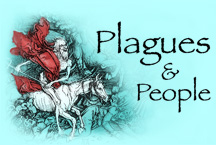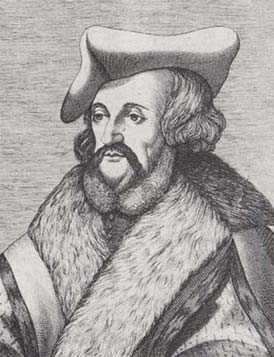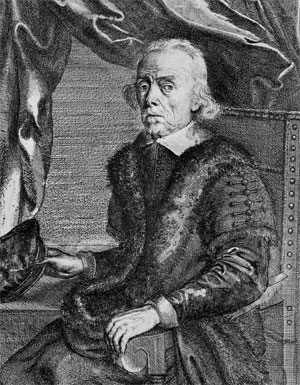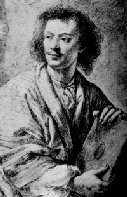HISTORY 135F

Infectious and
Epidemic Disease in History
Department of History
University of California, Irvine
Instructor: Dr. Barbara J. Becker
HISTORY 135F

Infectious and
Epidemic Disease in History
Department of History
University of California, Irvine
Instructor: Dr. Barbara J. Becker
Sixteenth century Views on Medical Practice |
|
| On Contagion, Contagious Diseases and Their
Cure (1546)
by Girolamo Fracastoro (1478-1553) Fracastoro was a contemporary of Paracelsus Viewed infection as a putrefaction Contagious disease is transmitted by:
Each and every disease has a preferred target. |

|
Seventeenth century Views on Medical Practice |
||||||||||||
by John Hall, physician-herbalist (c. 1575-1635) Observation XV Mr. Hunt of Stock-green, aged about 46. Labouring of a grievous Scab and Itch, was thus helpt:
of each a like quantity, as much as you please; draw out the juices, of which take boiling it in whey to the consumption of the whey, always scumming of it; after it is boiled suffer it to settle. Drink every day a good draught of it cold, with sugar. This is Syrup of Scabious by Johannes Anglici, and a secret by which he cured many of the Scab and which I have cured also. |
||||||||||||
Questioning Galen |
||||||||||||
The humanist movement encouraged practitioners to make their own direct observations of medical phenomena. Dissection gave medical school teachers and students an opportunity to view animal (often pigs) and (in some cases) human anatomy firsthand. Rather than rely on the authority of books, dissectors wanted to see the tissues and observe their structure for themselves. Nevertheless, some of Galen's assertions remained unchallenged. For example, Galen claimed the heart has two principal chambers.
In Galen's scheme, the heart's right chamber (3) receives blood from the liver via the vena cava (2). The blood seeps into the heart's left chamber (4) through a series of small nearly invisible pores in the thick wall (septum) separating the two chambers. Although early modern dissectors did not see these pores, they assumed that the pores had to be there. How else could the blood move from one side of the heart to the other? Some assumed the pores to be too small to see. Clearly Galen was a superior observer.
The illustration above shows how German physician Magnus Hundt (c. 1449-1519) depicted the heart in this schematic sketch from his book Antropologium (1501).
Hundt's contemporary, Leonardo da Vinci (1452-1519), drew in the pores of the heart's septum in his own drawing (c. 1510) which he based on a dissection. Italian physician Jacobo Berengario da Carpi (c. 1460-1530) dissected hundreds of bodies. In 1523 he published a book of anatomical drawings based on his observations. Here is his depiction of the human heart:
In 1543, Andreas Vesalius (1514-1564) published De Humani Corporus Fabrica (On the Fabric of the Human Body). In his detailed drawing of the human heart, Vesalius showed the pores (R) that he believed were in the wall separating the two chambers even though he was unable to see the pores himself.
Vesalius wrote:
After more dissections and more serious thinking about this perplexing puzzle, Vesalius began to change his mind. In 1555, he wrote:
Vesalius aroused some controversy by questioning of Galen's view of the heart's structure. But his skepticism and confidence in his own firsthand observations encouraged others to question Galen's authority even further. |
||||||||||||
Anatomy Theater (Leiden, 1610) |
||||||||||||
Notice the skeleton in the foreground representing Adam accepting an apple from a skeleton of Eve. Instructive posters around the anatomy theater provide students and onlookers with reminders of the fragility of life and inevitability of death. The signs -- beginning with the one in the upper righthand corner (near the skeleton of the knight on the horse) and moving counterclockwise around the room -- read as follows: "Know yourself", "We are but dust and shadow", "Death takes away the scepter as well as the spade", "The principle of death is born", "From the moment we are born, we begin to die", and "Death is everything's final limit". |
||||||||||||
William Harvey (1578-1657) |
||||||||||||

|
De Motu Cordis (1628)
[On the Motion of the Heart] William Harvey was an English physician. After completing his studies at Cambridge and at the medical school in Padua, Italy, Harvey returned to England where he was elected to the College of Physicians. In 1618, having made a name for himself as a lecturer and medical practitioner, Harvey was appointed court physician to King James I. By that time, he had already begun experiments to test Galen's theories on the ebb and flow of blood within the body. He wondered why valves only appeared in veins, not arteries. He was even more puzzled by the enormous amount of blood that Galen's scheme required to keep the body nourished. |
|
Based on this and other observations, Harvey rejected Galen's notion that blood is continuously being generated, distributed, and converted into flesh in a one-way process from liver to heart to extremities. He suggested that the body contains a fixed amount of blood at all times and that the heart serves as a pump, keeping that blood moving through the body in a neverending cycle. |
by Nicholas Culpeper (1616-1654) |
|
Epistle to the Reader. All other Authors that have written of the nature of Herbs, give not a bit of reason why such an Herb was appropriated to such a part of the body, nor why it cured such a disease. Truly my own body being sickly, brought me easily into a capacity, to know that health was the greatest of all earthly blessings, and truly he was never sick that doth not believe it. I considered that all medicines were compounded of Herbs, Roots, Flowers, Seeds, &c., and this first set me to work in studying the nature of simples, most of which I knew by sight before; and indeed all the Authors I could read gave me but little satisfaction in this particular, or none at all. I cannot build my faith upon Authors' words, nor believe a thing because they say it, and could wish every body were of my mind in this,-- to labour to be able to give a reason for every thing they say or do. They say Reason makes a man differ from a Beast; if that be true, pray what are they that, instead of reason for their judgment, quote old Authors? Perhaps their authors knew a reason for what they wrote, perhaps they did not; what is that to us? Do we know it? Truly in writing this work first, to satisfy myself, I drew out all the virtues of the vulgar or common Herbs, Plants, and Trees, &c., out of the best or most approved authors I had, or could get; and having done so, I set myself to study the reason of them.... I consulted with my two brothers, DR. REASON and DR. EXPERIENCE, and took a voyage to visit my mother NATURE, by whose advice, together with the help of DR. DILIGENCE, I at last obtained my desire; and, being warned by MR. HONESTY, a stranger in our days, to publish it to the world, I have done it.... Instructions for the right use of the book. First, Consider what planet causeth the disease; that thou mayest find it in my aforesaid Judgment of Diseases. Secondly, Consider what part of the body is afflicted by the disease, and whether it lies in the flesh, or blood, or bones, or ventricles. Thirdly, Consider by what planet the afflicted part of the body is governed: that my Judgment of Diseases will inform you also. Fourthly, You may oppose diseases by Herbs of the planet, opposite to the planet that causes them: as diseases of Jupiter by herbs of Mercury, and the contrary; diseases of the Luminaries by the herbs of Saturn, and the contrary; diseases of Mars by herbs of Venus, and the contrary. Fifthly, There is a way to cure diseases sometimes by Sympathy, and so every planet cures his own disease; as the Sun and Moon by their Herbs cure the Eyes, Saturn the Spleen, Jupiter the Liver, Mars the Gall and diseases of choler, and Venus diseases in the instruments of Generation. |
Thomas Sydenham
(1624-1689) |
|
Sydenham was regarded as the leading medical practitioner of his time. Here is an excerpt from his Medical Observations concerning the History and Cure of Acute Diseases (1676): A disease, in my opinion, how prejudicial soever its causes may be to the body, is no more than a vigorous effort of Nature to throw off the morbific matter, and thus recover the patient. For as God has been pleased so to create mankind, that they should be fitted to receive various impressions from without, they could not, upon this account, but be liable to different disorders; which arise (1) either from particles of the air, as having a disagreement with the juices, insinuate themselves into the body, and mixing with the blood, taint the whole frame; or (2) from different kinds of fermentations and putrefactions of humours detained too long in the body, for want of its being able to digest, and discharge them, on account of their too large bulk or unsuitable nature. Sydenham was concerned mainly about the practical questions of medical practice. He ignored Harvey's work on the circulation of the blood and later wrote:
|
|
| 1642 | Sydenham left his studies at Magdalen College, Oxford to join the Parliamentary army |
| 1646 | returned to Oxford |
| 1648 | became Bachelor of Medicine by "actual creation"--procedure by which
a degree is granted in a time of crisis or special circumstance without
the usual preparation and examination
appointed to a post at All Souls' College |
| 1651 | rejoined Cromwell's army |
| 1655 | married and (still untrained and unlicensed) began practicing medicine |
| 1658 | took examination and became a Licentiate of the College of Physicians |
| 1661 | Marcello Malpighi (1628-1694) announced his observation (with the aid of a microscope) of capillaries, the tiny blood vessels that connect the arteries and veins |
|
|
Sydenham fled London during the Great Plague |
| 1676 | became Doctor of Medicine at Cambridge University |
Popular Views on Medical Practice in the Seventeenth Century |
|
|
medical practice according to (Jean Baptiste Poquelin, 1622-1673) |

|
excerpts from Act II of
ACT II
Scene I Lysetta. What will you do, sir, with four physicians? Is not one enough to kill any one body? Sganarel. Hold your tongue. Four advices are better than one. Lysetta. Why, can't your daughter die well enough without the assistance of these gentlemen? Sganarel. Do the physicians kill people? Lysetta. Undoubtedly; and I knew a man who proved by good reasons that we should never say, such a one is dead of a fever, or a catarrh, but she is dead of four doctors and two apothecaries. Sganarel. Hush! Don't offend these gentlemen. Lysetta. Faith, sir, our cat is lately recovered of a fall she had from the top of the house into the street, and was three days without either eating or moving foot or paw; but 'tis very lucky for her that there are no cat-doctors, for 'twould have been over with her, and they would not have failed purging her and bleeding her.Sganarel. Will you hold your tongue, I say? What impertinence is this! Here they come. Lysetta. Take care. You are going to be greatly edified; they'll tell you in Latin that your daughter is sick. |
|
Scene II ...Lysette informs Mr. Thomès that a patient he recently treated is dead. M. Thomès. [The coachman is d]ead! Lysetta. Yes. M. Thomès. That can't be. Lysetta. I don't know whether it can be or not; but I know well enough that so it is. M. Thomès. He can't be dead, I tell you. Lysetta. And I tell you that he is dead and buried. M. Thomès. You are deceived. Lysetta. I saw it. M. Thomès. 'Tis impossible. Hippocrates says that these sort of distempers don't terminate till the fourteenth or twenty-first, and he fell sick but six days ago. Lysetta. Hippocrates may say what he please; but the coachman is dead.... |
|
Scene III
M. Thomès. ...what side do you take in the dispute betwixt the two physicians, Theophrastus and Artemius? for 'tis an affair which divides all our body. M. Fonandrès. I am for Artemius. M. Thomès. And I likewise; not but that his advice killed the patient and that of Theophrastus was certainly much the better; but he was wrong in the circumstances, and he ought not to have been of a different opinion to his senior. What say you of it? M. Fonandrès. Without doubt. The formalities should be always preserved whatever may happen. M. Thomès. For my part I am as severe as a devil in that respect, unless it's amongst friends. Three of us were called in t'other day to a consultation with a strange physician. I stopped the whole affair, and would not suffer 'em to go on unless things went in order. The people of the house did what they could, and the distemper increased; but I would not give an inch. The patient died bravely during this dispute. M. Fonandrès. 'Twas well done to teach people how to behave, and to show 'em their mistake. M. Thomès. A dead man is but a dead man, and of no consequence: but one formality neglected does a great prejudice to the whole body of physicians. |
|
Scene IV
Sganarel. Gentlemen, my daughter's oppression increases, pray tell me quickly what you have resolved on.… M. Thomès. Sir, we have reasoned upon your daughter's distemper; and my opinion, as for my part, is that it proceeds from a great heat of blood: so I'd have you bleed her as soon as you can. M. Fonandrès. And I say that her distemper is a putrefaction of humors, occasioned by too great a repletion, therefore I'd have you give her an emetic. M. Thomès. I maintain that an emetic will kill her. M. Fonandrès. And I, that bleeding will be the death of her... M. Thomès. Do you remember the man you killed a few days ago?M. Fonandrès. Do you remember the lady you sent into the other world three days since? M. Thomès. (To Sganarel.) I have told you my opinion. M. Fonandrès. (To Sganarel.) I have told you my thoughts. M. Thomès. If you don't bleed your daughter out of hand, she's a dead woman. M. Fonandrès. If you do bleed her, she'll not be alive in a quarter of an hour hence. |
|
Scene V Sganarel. Which of the two am I to believe, and what resolution shall I take upon such opposite advices? (He turns to MM. Macroton and Bahys for advice.) Gentlemen, I conjure you to determine me, and to tell me without passion, what you think the most proper to give my daughter relief. M. Macroton. For, sir, to come to fact, I find your daugh-ter has a chro-ni-cal dis-ease, and that she may be in jeo-par-dy if you don't give her some assis-tance; for-as-much as the symptoms which she has are in-di-ca-tive of a fu-li-gi-nous and mor-di-cant va-por, which pricks the mem-branes of the brain; for this va-por, which we call in Greek at-mos, is caus-ed by pu-trid, te-na-ci-ous, and con-glu-tinous humors, which are con-tain-ed in the abdomen. M. Bahys. And as these humors were engendered there by a long succession of time; they are over-baked there, and have acquired this malignity, which fumes towards the region of the brain. M. Macroton. So that to draw a-way, loos-en, ex-pel, e-va-cu-ate the said hu-mors, there must be a vi-go-rous pur-ga-tion. But first of all, I think it proper, and it would not be in-con-ve-ni-ent to make use of some lit-tle a-no-dyne me-de-cines; that is to say, lit-tle e-molli-ent and de-ter-sive cly-sters, and re-fresh-ing ju-leps and sy-rups, which may be mix-ed in her bar-ley wa-ter. M. Bahys. Afterwards we'll come to purgation and bleeding, which we'll reiterate if there be need of it. M. Macroton. Not but for all this your daughter may die; but at least you'll have done some-thing, and you'll have the con-so-la-ti-on that she di-ed ac-cord-ing to form. M. Bahys. It is better to die according to the rules than to recover contrary to 'em....
|
|
 |
| Go to: |
|
|